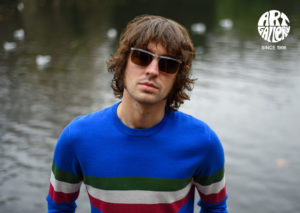
She had the perfect look that at the time, encapsulated the French take on 60s pop culture. Beautiful and chic she most certainly was, but I’ll be honest, and say apart from identifying her in photos of the period, I know very little else about her career. Yes, I remember a couple of very Euro-Pop singles and her memorably appearing up in the film Grand Prix but that’s about it.
So, high time, I learnt more. You coming along?
Françoise Madeleine Hardy was born in Paris, France in 1944, with the country still under Nazi occupation. Madeline, her mother, from a working-class background, effectively raised Francoise and her sister Michele as a single parent, with their wealthy father Etienne, being mainly absent from their lives. Francoise was a solitary child, enduring a strict upbringing at home and a troubled one at the Catholic school she attended.
‘This is most likely where the feeling of shame that has tormented me non-stop since I was a child, took root. Everything fell into place: the social status of my parents who I naively believed were divorced, the good sisters’ constant complaints that my father was generally a year behind in his payments, and the various differences with the other girls.’ Her father would later come out as gay.
A bright child, she achieved her baccalauréat (the equivalent of A levels) two years earlier than most at just 16. She received a guitar from her father as gift to mark that achievement and so began to compose her own songs. Whilst studying German at the Sorbonne, she performed at the Moka Club each Thursday trying out her new repertoire .
She auditioned for both the Pathe and Philips record labels and was turned down by both, but undaunted she joined Le Petit Conservatoire de la Chanson in 1961, with the aim to learn the showbiz ropes for any future radio and TV appearances, under the tutelage of Mireille Hartuch.
That same year, she auditioned again, this time for Disques Vogue and a well-received demo coupled, with her long-haired good looks, earned her a year long contract . The ‘yeah yeah’ phrase in her song La Fille Avec Toi was picked up on by the French press who described her sound and look as ‘ye-ye’ and a pop scene with the same name, was born. She released an EP in May 1962, which contained Oh Oh Cheri plus a couple of her own tunes, including Tous les garçons et les filles, which went on to receive widespread radio play and TV exposure.
Photographer, and her first serious boyfriend, Jean-Marie Périer – ‘She was the opposite of all the French new artists trying to look and sound American. And her melodies were sad, she didn’t try to make them dance the twist.’
Vogue then rush released more material to build on her newfound fame, and sales of two and half million records were later recorded for Tous les garçons et les filles. She toured France in 1962 and early 1963 as her new material, such as J’suis Daccord topped the French pop charts. She featured on the cover of the magazine Paris Match, which she celebrated by signing a 5-year extension with her record label . Her profile went from strength to strength with appearances at the legendary Olympia in Paris, where in 1966 she would meet an infatuated Bob Dylan. He noticed her among the concert’s audience and then refused to go back on stage to perform the second half unless she went to his dressing room. Which she did.
A full European tour then ensued, and she became very successful in Italy with the song – Quelli della mia età and then somewhat bizarrely represented Monaco in the 1963 Eurovision Song contest, coming in 5th with L’amour S’en Va
‘I didn’t enjoy that at all, everything, the trappings, when all of a sudden you become very famous. I don’t like that at all. I am not comfortable with my professional life really, so the word ‘icon’ is as though you were talking about someone else, it’s not me really.’ She said later.
The film world then came calling and she began to take the many film roles that fell her way, starting in 1963 as Ophelia in Roger Vadim’s Château en Suède. She also made a cameo appearance in What’s New Pussycat and then landed a decent part in Grand Prix in 1966, after being spotted by the film’s director Joh Frankenheimer as she emerged from a London night club.
She was savvy enough, once the Beatles arrived on the pop scene – a moment memorably described by my friend, the musician and writer Simon Spillet, as ‘The four scouse men of the apocalypse’ – to know she had to upscale her material. She came to London to record at the Pye studios with Tony Hatch and sang English versions of Ton Meilleur and performed Catch A Falling Star on the TV show Ready Steady Go!
Despite the Fabs and The Stones snapping at the heels of the early 60s pop scene, she had a top 20 hit in the UK with All Over the World which also achieved success in Australia, New Zealand and South Africa. A debut album The Yeh Yeh Girl from Paris then hit the US market, resulting in an appearance on the TV show Hullabaloo.
When back in London, she mixed with the new pop royalty, having dinner with members of The Beatles and receiving regular visits at her hotel from Brian Jones of the Stones.
‘I think I was a source of fascination for the English pop musicians. I heard much later that there was a rumour that I was a lesbian, but really, I was just shy and unsure. When Brian Jones introduced me to his girlfriend, Anita Pallenberg, I was very flattered and charmed, but then I heard that they were each trying to figure out which one of them I was interested in sexually. Of course, this was the very last thing I was interested in. I was unbelievably innocent.’
In 1968, at age 24, around the same time that she stopped touring due to terrible stage fright, she rose to the top of pop charts all over Europe with It Hurts to Say Goodbye written by Serge Gainsbourg. Her domination of Europe continued with German language versions of her songs staying in the charts for weeks on end.
Then, tired of record label constraints, she set up her own production company – Hypopotam – and publishing company Kundalini – both of which allowed her to fund her own projects. Ultimately, it was less commercial than her earlier period, but none the less it was a happy time for Hardy. Then due to the student riots in May of that year, she and her new boyfriend Jacques Dutronc left Paris
‘We went to Corsica, it was bliss. In my view, May ’68 and the student rebellion didn’t achieve anything. It was simply the expression of a social and sexual evolution which had started in the early ’60s. In pop music, Elvis Presley, the Beatles and the Rolling Stones had already paved the way to a change in society.’
Unsurprisingly, due to her stunning looks, she was in constant demand by fashion companies to wear their garments. She was a muse to Japanese designer Rei Kawakubo, who named her label Comme des Garçons after a lyric in a Hardy song Tous les garçons et les filles. André Courrèges, Yves Saint Laurent and Paco Rabanne, also all employed her services.
‘Being taken up by fashion houses was work, things I had to do, a chore. I didn’t enjoy it at all. It is quite impossible to stand, to be admired too much, it is not a normal situation.’
She worked next with Tony Cox, an arranger from the UK and this resulted in the 1972 album ET si je m’en toi L’eclairage, later known as the orange album, due to its cover (Am I the only one who can see a TSC pattern developing here?) and the pair went on to make the covers album If You Listen.
Tony Cox – ‘Françoise was good in that she liked things to be slightly more adventurous than the norm. There was a bit of the Left Bank about her – she’s not your average pop singer, that’s for sure.’
She and Jacques Dutronc had a son Thomas in 1973, and the couple married in 1981.
‘I don’t know if I should talk about this stuff but, I had a little health problem and since I am of a hyper-anxious, hypochondriac temperament, I already saw myself in heaven, or in hell. So, I had gone to see a lawyer to find out what would happen if something happened to me. And as a result, everyone had an interest in Jacques, and I being married. That’s why we got married. Stupidly! I have always considered marriage as an uninteresting formality.’ No longer together, the couple have never divorced.
She took a break during the 80s, before resuming her singing career in 1994 with Virgin Records. She sang on the French version of To the End by Blur in 1995 and followed that in 1997, singing on the track Jeanne with the French group, Air.
Outside of music, she released her first novel L’Amour fou in 2012 and has studied astrology for many years. After being diagnosed with Laryngeal cancer in 2021, she then announced she could not sing anymore as a result of her treatment. She had already fought MALT lymphoma in 2004
Listening back to some of her early work, maybe there is a claim it was more style over substance, but she was massive at the time of those recordings as the likes of Malcolm McLaren knew well –
‘(she was the) utmost of the pinup girl, pinned to the walls of every trendy pop apprentice’s bedroom down in Chelsea. Many bands in their prime, like the Beatles or the Stones, dreamt of dating her.’
Last word to Bob Dylan who had included a beat poem to her on the back cover of his 1964 album Another Side of Bob Dylan.
‘For Françoise Hardy/at the seine’s edge/a giant shadow/of Notre Dame/seeks t’ grab my foot/Sorbonne students/whirl by on thin bicycles/swirlin’ lifelike colours of leather spin…’
The Mumper of SE5
Read The Mumper’s other weekly musings on the The Speakeasy Blog page
THE SPEAKEASY VOLUME 3 – AVAILABLE NOW
THE SPEAKEASY Volume Three by Mark Baxter (The Mumper)
Illustrations by Lewis Wharton
Foreword by Eddie Piller
Available to ORDER exclusively in the Art Gallery Clothing SHOP
ART GALLERY CLOTHING
JOIN US
Sign up to our newsletter and receive an exclusive promo code, latest news & Art Gallery Clothing offers.
Newsletter Signup




